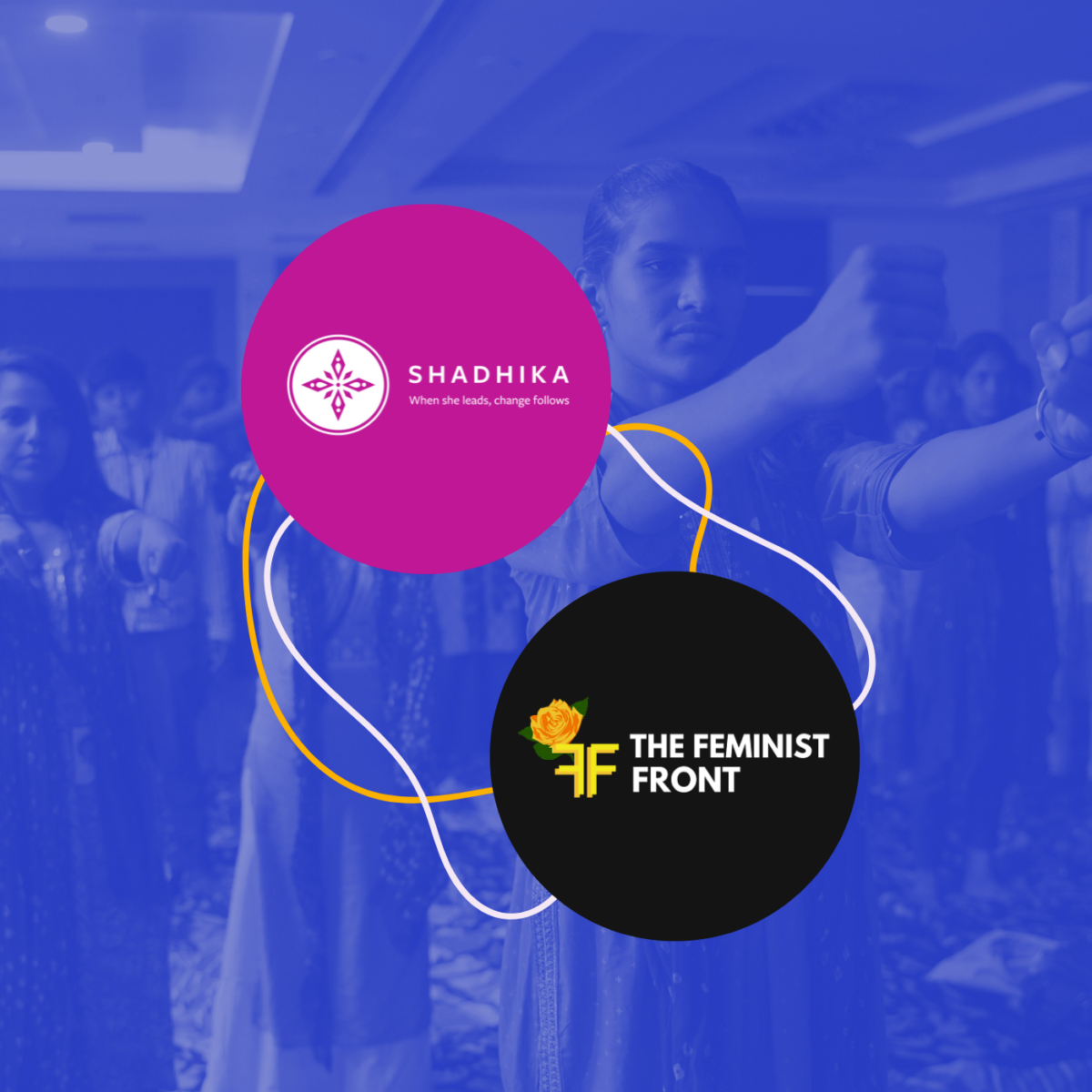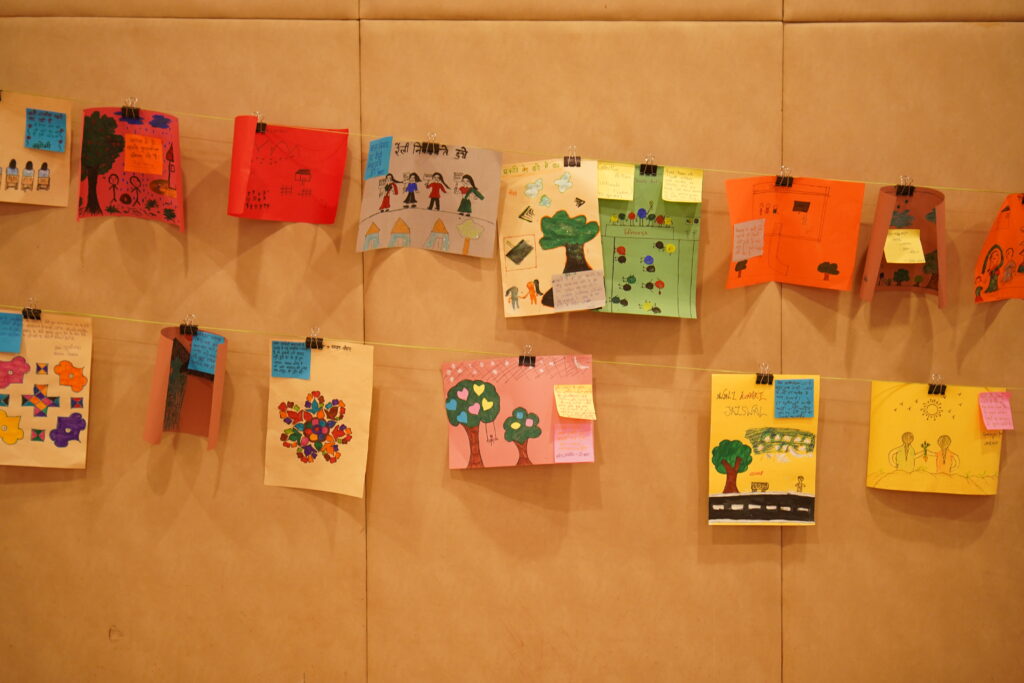
Collective action means that we are stronger together, and together, we stand in solidarity by supporting grassroots movements in every way possible.
Collective Art and Action: Part 2 of 2
By Urmila Reghunath, Communications Manager (India Consultant)
February 29, 2024
Reading Time: 7 minutesShadhika is hosting a virtual art exhibition featuring 25 works by Shadhika Scholars (Cohort of 2023) exploring their hopes and experiences of what collective action means for feminist leadership. Embodying the spirit of collective action shared through our exhibition, Shadhika has partnered with The Feminist Front (The FF) – a youth of color-led organization organizing 15-35 year olds for gender and racial justice in the U.S., to highlight the shared ways in which gender justice activists and youth leaders are working towards a feminist future around the world.
Read on to learn from RJ, the Operations and Communications Coordinator at The Feminist Front and Urmila, our Communications Manager (India Consultant) at Shadhika about the history and impact of collective action in the U.S. and India.
This blog post is being published in 2 parts. This is part 2. Click here to read part 1.
How has collective action helped tackle gender injustice in the U.S/ in India?
UR: Women-led grassroots action has been a powerful transformative force addressing topics ranging from ecofeminism to gender-based violence and mobility throughout India’s history.
The memorable Chipko movement of the 1960s and 70s saw protestors, primarily women from affected villages, hugging trees to oppose deforestation, while the women-led Narmada Bachao Andolan raised collective consciousness on the nuances of displacement and ecological harm in the face of large dam projects. The horrific Nirbhaya rape case in 2012, and the mass protests that erupted across the country in response marked a watershed moment that highlighted to a global audience the shocking rates of gender-based violence in India. This enormous power that organic movements by women wield was evident again both in India and globally through the #MeToo campaign and in New Delhi at the Shaheen Bhag protest gatherings and the farmer protests in 2020, with each of these movements advancing the discourse and collective understanding on the importance of intersectional and timely ways to organize in the public sphere.
In less visible, but equally important ways, Shadhika’s local Program Partners who are women-led, grassroots organizations, are working with and for their communities against child marriage, trafficking and devadasi systems, and for child protection, access to education, and self-determination of one’s life path.
Each act of solidarity and leadership on the ground catalyzes waves of change and paves the way to shifting mindsets and breaking systems of oppression based on caste, class, religious and gender based discrimination.
RJ: In advocating for the publication of the Equal Rights Amendment over 100 years after it was initially written, we take inspiration from past movements’ use of direct collective action to make the current movement for equal rights in the U.S. possible. One of the movements that initially inspired people to draft and fight for the ERA was the Silent Sentinels for Women’s Suffrage in 1917. This two and a half year long demonstration organized by ERA Co-Author Alice Paul mobilized over 2,000 women to protest non-violently outside of the White House until Congress passed the 19th Amendment creating constitutional protections for women’s right to vote.
After the 19th Amendment was published some advocates for suffrage wrote an early version of the ERA. The pioneering civil rights activist Pauli Murray helped reinvigorate the fight for equal rights with women like Florynce Kennedy, Shirley Chisholm, and Barbara Jordan. Murray also helped found the National Organization for Women (NOW). In February of 1970 members of NOW used direct action to disrupt Senate hearings to demand that Congress take up the Equal Rights Amendment which had been introduced to each session of Congress for almost 50 years without any official actions. Within two years of the protest the ERA passed both the House & the Senate with over 80% support, sending the Amendment to the States for ratification.
Our contemporary fight for the ERA was deeply shaped by the work of women of color both within and outside the ERA Movement. The Third World Women’s Alliance (1968-1980) formed from membership of the Student Nonviolent Coordinating Committee (SNCC) of the Civil Rights Movement changed the way we organize, build coalitions, and lead collective actions. The Third World Women’s Alliance centered women of color in the fight for abortion and reproductive rights while resisting sexism and misogyny in social justice movements. The Third World Women’s Alliance was truly intersectional, focusing on how racism, sexism, classism, and imperialism affect women’s lives globally, setting the stage for the Combahee River Collective and our focus on interlocking oppressions.
The Feminist Front & partners like Generation Ratify now rally for abortion access, reproductive rights, LGBTQ protections, and more as we call for the White House to Publish the ERA & Congress to pass laws validating the ERA as the 28th Amendment to the U.S. Constitution. Our approach involves educating young people around the country on social media, with online workshops on the ERA, and in person events that tie the struggle for abortion access and LGBTQ+ rights to the solutions offered by the Equal Rights Amendment both federally and in specific states with ERAs in their state constitutions. After educating young people we do advocacy work aimed at voters and politicians, direct actions like dies-in to end the filibuster or literal roadblocks to urge Congressional action. We encourage civic engagement by registering young people to vote every month and educating folks about ballot measures and constitutional amendments in states like Arizona and Nevada.

What are some ways in which allies can join in collective action with the leaders on the ground?
UR: Local leaders who are working with their communities, with deep knowledge of their contexts have the wisdom and power to create long-term change. Supporting these leaders through financial donations, in-kind support, or shared resources are acts of allyship that have immediate and tangible impact.
As allies, we also need to seize the opportunities where we can show up in solidarity, listen to voices from the ground, and continue learning about the nuances of intersectional justice movements. The upcoming art exhibition featuring Shadhika Scholars and young Shadhika supporters in the U.S., as well as The Feminist Front’s #ERANow Art Series are unique opportunities to engage with these young community leaders, and understand how the spirit of collective action transcends the limits of geography.
RJ: Join us from wherever you are for our monthly Volunteer Meeting and our monthly Feminists Against Voter Suppression: Electoral Justice Now text-banks where we register young people to vote, encourage civic engagement, and educate voters on both the process and some of the polices on the ballot. We encourage everyone to advocate for the Equal Rights Amendment to your representatives in Congress and educate your family and friends about the protections derived from Constitutional gender equality to ensure that not one more year goes by without sex equality explicitly protected in the US Constitution. Join us to make social media content about the ERA!
Finally, sign up for our Newsletter and follow us on your favorite social media platforms to learn about upcoming events, advocacy and direct action opportunities, and more about reproductive justice, transnational abolition, and the fight for equal rights under the law.
Read more
